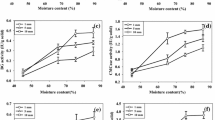Abstract
Washings from long staple cotton (Gossypium barbadense L.) new variety Barakat, yielded Aspergillus flavus, A. nidulans, A niger. A. terreus, A. versicolor and Cladosporium herbarum. The number of propagules increased with R. H. following 6 month-storage. A. terreus was less favoured.
Higher R. H. impaired fibre length and strength of both raw non-sterilized and inoculated sterile lint whilst the sterilized non-inoculated control was insignificantly affected, even at 100% R.H. Artificial inoculation of lint with Chaetomium globosum and A. nidulans significantly affected the efficiency of yarn spinnability at 80, 90 and 100% R.H. (P=0.05).
Hyphae, which wound in a helical pattern around the fibre, intermittently dissolved fibre wall causing fibre fragility.
Similar content being viewed by others
References
Abdalla, M. H. & El-Tayeb, N. M., 1981a. Preliminary survey of cotton flower mycoflora from Sudan Gezira. Brit. mycol. Soc. Trans. (in press).
Abdalla, M. H. & El-Tayeb, N. M., 1981b. Cotton boll mycoflora from Sudan. Mycopathologia (in press).
Abdalla, M. H. & El-Tayeb, N. M., 1981c. Implication of fungi in the loss of strength of Sudanese cotton fibre. J. Univ. Kuwait (Sc.) (in press).
Ayerst, G., 1969. The effect of moisture and temperature on growth and spore germination in some fungi. J. Stored Prod. Res. 5: 124–127.
Block, S. S., Rodriquez-Torrent, R., Cole, M. B. & Prince, A. E., 1963. Humidity and temperature requirement of selected fungi. In: Development of Industrial Microbiology. Plenum Press, New York.
Booth, C, 1971. Introduction to general methods. In: Methods in Microbiology; vol. 4, Academic Press, London.
Christensen, C. M., Papavizas, G. C. & Benjamin, C. R., 1959. A new halophilic species of Eurotium. Mycologia 51: 636–640.
Cruikshank, I. M. A., 1958. Environment and sporulation in phytopathogenic fungi. I. Moisture in relation to the production and discharge of conidia of Peronospora tabacina Adam. Aust. J. Biol. Sc. 11: 162–170.
Gregory, P. H. & Lacey, M. E., 1963. Mycological examination of dust from mouldy hay associated with farmers lung disease. J. Gen. Microbiol. 30: 75–88.
Halliwell, G., 1963. Advances in Enzymatic Degradation of Cellulose and Related Materials. (Ed. E. T. Reese); Pergamon Press, Oxford.
Halliwell, G. & Rias, M., 1970. The formation of short fibres from native cellulose by components of Trichoderma koningii cellulase. Biochem. J. 116: 35–42.
Hawker, L. E., 1950. Physiology of Fungi. University of London Press, London.
Henderson, L. S. & Christensen, C. M., 1961. Post-harvest control of insects and fungi. Seeds. The Yearbook of Agriculture. U.S. Dept. of Agriculture, Washington, D.C.
Huston, B. R. & Garber, R. R., 1959. A lint rot of cotton in California caused by Nigrospora oryzae. Plant Dis. Reptr. Suppl. 259: 233–235.
Hyde, M. B., 1950. The sub-epidermal fungi of cereal grains. A survey of the world distribution of fungal mycelium in wheat. Ann. Appl. Biol. 37: 179–186.
Kaufman, D. D., Williams, L. E. & Summer, C. B., 1963. Effect of plating medium and incubation temperature on growth of fungi in soil dilution plates. Can. J. Microbiol. 9: 741–751.
Marsh, P. B., 1957. Microscopic observations on fibres subjected to enzymatic degradation. Textile Res. J. 27: 913–916.
Marsh, P. B. & Kerr, T., 1961. Uncollapsed fibres associated with boll rot in cotton. Plant Dis. Reptr. 45: 550–551.
Reese, E. T. & Mandels, M., 1963. Enzymatic hydrolysis of cellulose and its derivatives. In: Methods in Carbohydrate Chemistry; vol. 3, Academic Press, New York.
Sadov, F., Korchagin, M. & Matetsky, A., 1973. Chemical Technology of Fibrous Cotton. M.I.R. Publishers, Moscow (English translation).
Simpson M. E. & Marsh, P. B., 1969. Microscopic observations on fungi associated with cotton boll rot fibres. Mycologia 61: 987–996.
Sitte, P., 1973. Fine structure of fruit hair cell wall in Clematis. Ber. Dtsch. Bot. Ges. 86: 551–561. (English summary).
Stands, I. E., Fiori, L. A. & Groves, N. H., 1962. The utilization of Diplodia-damaged boll-rot cotton. I. Effect on yarn properties and spinning efficiency. Textile Res. J. 32: 1013–1022.
Waksman, S. A., 1927. Principles of Soil Microbiology. Bailliere, Tindall & Cox, London.
Author information
Authors and Affiliations
Rights and permissions
About this article
Cite this article
Abdalla, M.H., El-Tayeb, N.M. Spoilage of stored cotton fibre from Sudan Gezira. Mycopathologia 75, 173–177 (1981). https://doi.org/10.1007/BF00482813
Issue Date:
DOI: https://doi.org/10.1007/BF00482813




